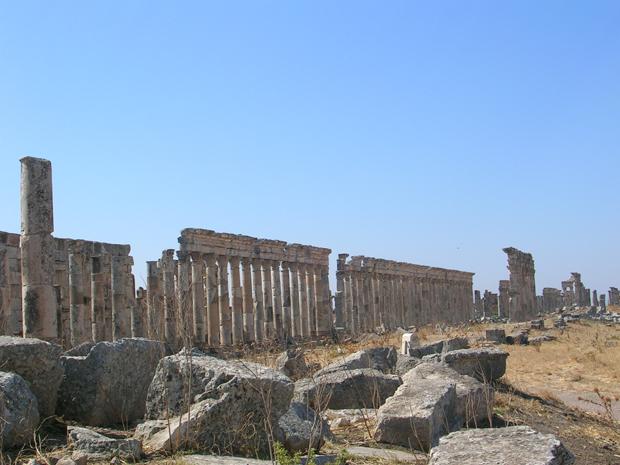Researchers document great damage to Syrian antiquities
The ruins of Afamia in Syria. They have since been looted and damaged by tanks, military emplacements and shelling. (Photo courtesy of Emma Cunliffe.)
Emma Cunliffe sits in a tiny graduate student’s office on the medieval campus of the University of Durham. But her mind is thousands of miles east, in Syria.
Every day she goes online, sometimes for a few hours, to review the Facebook feeds of Syrian groups for word about damaged sites. She’ll scroll past horrific photos of dead children till she comes across mention of a new archaeological site that was shelled or plundered.
She says it’s incredible just how much you can find out from these posts.
“It’s a new world online now,” she said. “The prevalence of social networking sites like Facebook, ease of access to YouTube, and the way that most people’s mobile phones can take video, means that, all those people who are desperate to share information have a real easy way to upload it and make it accessible.”
Cunliffe did her doctoral research monitoring Syrian archaeological sites with satellite imagery. When fighting turned fierce in Syria, she began to consult imagery much closer to the ground — videos and photos posted by concerned Syrian citizens. Sites were being damaged and also looted.
“As much as some people in an area might loot, others will be quite horrified by the fact that’s happening,” Cunliffe said. “There are videos, for example, of looting at least two of the dead cities.”
The YouTube video above is one she found, showing damage and looting to one of those dead cities of northern Syria. These were cities built between the first and eighth centuries and then suddenly abandoned. They’re a favorite of archaeologists.
“The preservation is incredible,” Cunliffe said. “They are like being in ghost towns. That’s why they are called the dead cities.”
A Syrian citizen shot the video, and set it to somber traditional music. It documents extensive looting to the ancient ruins there, including Roman tombs dating to the first century.
A memo from the Syrian prime minister leaked last year claimed that criminals specializing in the theft of antiquities had smuggled special tools and satellite communication devices into Syria and were planning daring thefts at museums.
And indeed, some ancient statues have been reported stolen.
“It’s hard to know where they ended up,” Cunliffe said. “They’re rumored to have been sold on the black markets of Japan, Russia and the Gulf countries. So, for example, a cylinder seal, a Bronze Age artifact you would find in Syria or Iraq. They’re about the size of my thumb. These used to be worth £1,000, £10,000 ($16,000). There was one that went for about £250,000 last year. The prices on these things are increasing exponentially. Which can only reflect an increase in demand.”
Cunliffe says the Syrian government’s antiquities department has started a campaign to try to educate the public not to loot. Still, the list of damaged and plundered sites continues to grow.
Cunliffe’s report on damaged historical sites in Syria was published in May, but it’s already out of date. The table of contents runs eight pages long, single spaced, but alongside the looting, people are dying.
It’s a question Cunliffe says some of her colleagues in the archaeology world have been asking. They wonder what’s the use of observing damage from afar. Her answer is when the fighting is over and Syria begins to rebuild, there will be a thorough list to sift through and help in deciding what to recover first.
“There will be a record of damage, it will be a place to start,” she said. “A lot of these are going to provide very necessary tourist revenue.”
It’s not just about the money, though. More than anything, she says, the list makes you ponder the extent of the damage to historical treasures.
Along with the enormous loss of life and massive human displacement, it’s one other tragic loss for Syria — and for world heritage.
